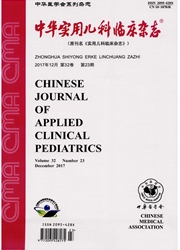

 中文摘要:
中文摘要:
目的 前瞻性研究出生18月龄晚期早产儿的神经发育情况。方法 2009年1月至12月四川省成都市北部地区三家医院出生的7584例活产新生儿,纳入标准的晚期早产儿89例,以健康足月儿170例为对照,随访18个月,矫正胎龄至40周时应用20项新生儿行为神经测查法,矫正年龄3、6、9、12和18月龄时应用贝利婴儿发展量表,进行神经行为发育评估,比较晚期早产儿和足月儿的神经行为发育情况。结果 成功随访的晚期早产儿63例,足月儿115例,矫正胎龄至40周时新生儿行为神经测查结果显示,晚期早产儿评分处于正常范围(≥37分)的比例明显低于足月儿(82.5% 比 94.8%),评分异常(〈35分)者明显高于足月儿(4.8% 比0),评分处于临界值(35~36分)者明显高于足月儿(12.7% 比5.2%),2组比较差异有统计学意义(Z = -2.707,P 〈0.05);贝利婴儿发展量表测查结果显示,晚期早产儿运动发育指数(PDI)得分中位数在矫正年龄3、6、9、12月龄时低于足月儿,差异均有统计学意义(t= -4.266、-4.594、-5.663、-2.584,P 均 〈0.05);晚期早产儿智力发育指数(MDI)得分中位数在矫正年龄3、6、9、12月龄时低于足月儿,差异均有统计学意义(t= -7.121、-7.829、-7.038、-6.002,P均〈0.05);矫正年龄18月龄时 MDI得分低于足月儿,差异有统计学意义(t= -4.115,P 〈0.05),PDI得分虽低于足月儿,但差异无统计学意义(t= -0.957,P 〉0.05)。结论 晚期早产儿神经行为发育在出生第1年明显延迟,18月龄时其智能发育仍落后于足月儿。应制定适宜的早教措施,促进晚期早产儿早期的神经行为发育。
 英文摘要:
英文摘要:
Objective To study the neurodevelopmental outcome prospectively at 18 months of the late preterm infants. Methods Data from 7 584 live born neonates were collected between January and December. 2009 in 3 hospitals located in the north of Chengdu City, Sichuan Province were collected ,89 late preterm infants were brought in- to study ; 170 healthy full - term infants were chosen as the controls randomly. Neurodevelopment outcome was assessed by using neonatal behavioral neurological assessment(NBNA) at 40 weeks corrected gestational age,and Bayley scales of infant development was performed to obtain the physical development index ( PDI ) and mental development index (MDI) at 3,6,9,12 and 18 months corrected age. Neurodevelopmental outcome of late preterm infants was studied compared with that of the term infants. Results Sixty - three neonates born at the late preterm phase and 115 neonates born at the term phase were successfully followed up. The NBNA scores of the late preterm infants at 40 weeks corrected gestational age were significantly lower than those of the term infants. The proportion of the late preterm infants whose scores i〉 37 was significantly lower than that of the term infants (82.5 % vs 94.8% ) , the proportion of late preterm in- fants whose scores 〈35 was significantly higher than that of the term infants(4.8% vs 0) ,the proportion of the late preterm infants whose scores in 35 - 36 was significantly higher than that of the term infants( 12.7% vs 5.2% ,Z = -2. 707 ,P 〈 0.05 ) ;At 3,6,9 and 12 months corrected age, the late preterm infants showed a significant lower PDI scores(t = - 4.266, - 4. 594, - 5. 663, - 2. 584) and MDI scores ( t = - 7. 121, - 7. 829, - 7. 038, - 6. 002) than those of the term infants(all P 〈0.05 ). Compared with the term infants, the late preterm infants still had lower MDI scores than the term infants at 18 months corrected age (t = -4.115, P 〈 0.05 ), but no difference was observed in PDI scores between late preterm an
 同期刊论文项目
同期刊论文项目
 同项目期刊论文
同项目期刊论文
 Targeting Hypoxia Inducible Factor-1 alpha: A Novel Mechanism of Ginsenoside Rg1 for Brain Repair af
Targeting Hypoxia Inducible Factor-1 alpha: A Novel Mechanism of Ginsenoside Rg1 for Brain Repair af In Vitro Effects of Hypoxia-Inducible Factor 1 alpha on the Biological Characteristics of the SiHa U
In Vitro Effects of Hypoxia-Inducible Factor 1 alpha on the Biological Characteristics of the SiHa U Signaling pathway involved in hypoxia-inducible factor-1 alpha regulation in hypoxic-ischemic cortic
Signaling pathway involved in hypoxia-inducible factor-1 alpha regulation in hypoxic-ischemic cortic Influence of hypoxia-inducible factor 1-alpha on neuronal apoptosis in a rat model of hypoxia- or hy
Influence of hypoxia-inducible factor 1-alpha on neuronal apoptosis in a rat model of hypoxia- or hy 期刊信息
期刊信息
